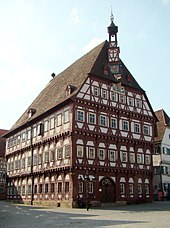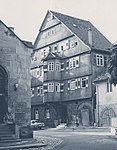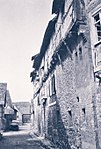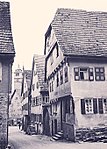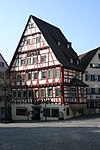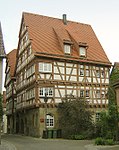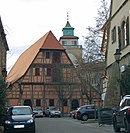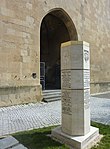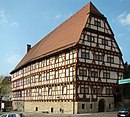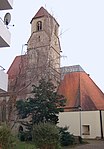City history of Grüningen
Grüningen , today Markgröningen was in the Middle Ages as Palatinate occupied royal estate : the imperial castle and since 1226 as a city with mayor occupied municipality have the kings of the preferably Swabian carrier of the Kingdom of storm flag than with this " Burggrafenamt 'related fief passed.
In 1336, Markgröningen and the imperial storm flag finally came into the hands of the Counts of Württemberg through purchase. As a second residence and official town , Grüningen experienced a second spring at the end of the Middle Ages and had the richest citizens of Württemberg. Its impressive town hall and the annual shepherd run that takes place in August keep the memory of this heyday alive.
The construction of the Ludwigsburg Palace and even the 1718 carried founding of the city of Ludwigsburg but on Grüninger office area led to a fundamental loss of importance Grüningen had its functions as a second residence and refuge of imperial storm flag as official district , high court , Dean's Office and Kameralamt left to the young competitors and on top bleed for their expansion. So Grüningen fell into stagnation and was finally renamed Markgröningen. The more recent history after this historical turning point is under Markgröningen .
Historical geography
Paradise on earth for an agricultural society
The fortunes of a city and its citizens depend on a wide variety of location factors. In the early Middle Ages, the basic prerequisite for settlement was the year-round safe availability of drinking water, which was particularly evident in the Wette spring basin , the original town center of Grüningen. A layer of the Lettenkeuper retaining groundwater also made it possible to plant numerous wells in the entire area of the old town, which was expanded in the 13th century.
In general, the natural geographic and in particular the agricultural location factors of Grüningen are in excellent shape: The extensive marking includes unsurpassed arable land in the Swabian region on the loess plain of the "Long Field" and loess deposits in the so-called outfield west of the Glems. The mild climate did the rest and enabled large-scale viticulture on the limestone slopes of the Glems and Leudelsbach valleys. Abundant surpluses of field crops and wine, linen and wool formed the basis for flourishing long-distance trade in the late Middle Ages.
This favorable position explains the long tradition of settlement and the special appreciation that Grüningen, which has been in Franconia since 496, was already part of in Carolingian times. Legend has it that the construction of the predecessor basilica of the Bartholomäuskirche was initiated on Königsgut by Hildegard , a wife of Charlemagne who died in 783 and granddaughter of the Swabian Duke Hnabi . Her brother Gerold the Younger was a close confidante and military leader of Charlemagne and is said to have been the first “ primicerius et signifer regis” ( foreman and ensign of the king) who gave him and his Swabian successors this office, which was linked to the Grüninger imperial fief , “to all Times "should have transferred. This tradition is given weight by an entry in the Lorsch Codex , in which Gerold the Younger is listed in 794, among other things, as Gaugraf in Glemsgau , that is, he held an office conferred by the king on site.
From Gruoninga via Grüningen to Mark (t) gröningen
In 779 Markgröningen was mentioned for the first time in a deed of donation for the Fulda monastery (here written Gruoninga and derived from an Alemannic local founder Gruono ). Even today, the former imperial and Württemberg residence town of Grüningen is colloquially called " Gröningen " (pronounced: grenẽŋə ) by the locals .

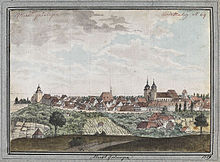

The prefix “Mark”, used for the first time in the 16th century, became increasingly official in the 18th century under Duke Karl von Württemberg and is supposed to refer to the border location on the Franconian-Alemannic Mark. However, this has not been relevant since the Cannstatt Blood Court (746), except for the agreement in this area with the diocese border between Constance and Speyer . The thesis that the prefix “Mark” refers to the former special status as a royal estate or former imperial fief that was always marked out from Glemsgau appears more conclusive, which could be proven by the name “Grüningen in der Mark” , which was once used by Heyd . However, in the 16th century, Grüningen had not been marked out as the Württemberg official city for around two hundred years.
When the prefix “mark” was initially only used as a distinguishing feature in the vernacular, both historical and academic explanations were irrelevant. Rather, at the time the name was added, (Mark-) Gröningen was associated with a nationally known characteristic: the supraregional important fair on Bartholomew's Day , which Lorenz Fries and Hans Grüninger equated with the important Frankfurt fair in 1527 and which could therefore actually have been eponymous. As elsewhere, this Bartholomew's Market was initially held on the occasion of the parish fair. Since Bartholomäus is not only the patron saint of the town church , but also the patron saint of the shepherds, and the date fits well into the annual schedule of the traveling sheep , it was probably opportune to combine the central guild day of the Württemberg shepherds with this fair. For foreign "nicknames", the "Barthel market " became even more a distinguishing feature from other Grüningen or Gröningen , of which there were a few in the country and Neckargröningen, a place in the immediate vicinity.
This derivation of the name is underlined by the said section in Fries, in which the local Hans Grüninger names the city in the title "Margt Grieningen", and by other sources: In 1533, the Baccalarius Michel Volland "ex Marckt Gröningen" was listed in the Tübingen matriculations. And so Matthäus Merian also referred to the alternative name "Marckt Gröningen" in his description of Grüningen published in 1643.
In keeping with this approach, the city painter Christian von Martens , who traveled through in 1819 and labeled his water-colored drawing of the city with " Markt-Gröningen ", obviously derived the prefix from Markt and therefore the prefix of Gröningen from the magistrate City mentioned supposedly wrong, but appropriately spelled correctly. The "t", which is often swallowed in the Swabian dialect at "Markplatz", could explain why it was lost in the prefix of the place name and thus steered the name interpreters on the wrong track.
Lost settlements around Grüningen
As a result of the concentration process in the course of urban development, but also as a result of epidemics and war damage, some settlements around Grüningen have fallen desolately (clockwise from northeast to north): Hörnle , Maulbronn , Laiblingen , Schönbühl , Böhringen , Konstatt and Caunstett near the Upper Mill , Aicholtz , Behind Instead , Kühlenbronn that Schlüsselburg with a suspected Burgweiler in Sankt Johännser and Talhausen on Grüninger district and the places Remmingen or Remmigheim with the Remminger Schlössle on bottom Berger denunciation, Vöhingen on Schwieberdinger , Pulverdingen and Leinfelden on Enzweihinger and watching Häußer and Castle Dauseck with a castle hamlet - after Georg Gadner the former powder thing - on Unterriexinger mark.
Surveying and recultivation of the field
In 1751/52 the "outer field" west of the Glems, largely neglected after the Thirty Years' War, was re-measured and divided into Zelgen for three-field farming. Obviously, the government already had the repopulation of the desert areas of Talhausen , Aicholtz , Pulverdingen and the Schönbühl in its sights, on the one hand to guarantee the cultivation of the areas far from the city and on the other hand to curb the increasing emigration of Württemberg subjects to Russia, Hungary or America: The aim was to enable impoverished farmers to build up a new existence through real division .
On the adjacent field map you can see from the "Hohen Markstein" on the new Vaihinger Straße that the Grüninger markings to the west of it were expanded to include the areas of desolate settlements, possibly Böhringen and Pulverdingen , up to today's Bundesstraße 10. The Hochgerich had also been relocated here, as can be seen from the two three-sleeper gallows.
High Middle Ages and early modern times
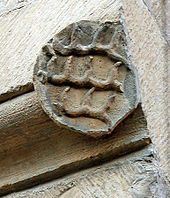


The imperial city and the Württemberg people
From the turn of the millennium, four Counts Werner with several counties are documented as "Reichssturmfähnriche", of which at least Werner III. and Werner IV. named as bearer of the Reichssturmfahne and the associated royal fiefdom to Grüningen, although they had far more possessions elsewhere: Count Werner IV. von Grüningen benefited from the Bempflingen Treaty and is said to be a close relative of the first verifiable Wuerttembergian Konrad von Württemberg and influential Hirsauer Abbot Bruno von Beutelsbach . Presumably the Counts of Württemberg derived from this last Werner von Grüningen, who died in 1121 without a male heir, the claim to the imperial storm flag and the associated Grüninger royal fief, which was always pursued with great energy .
In 1139 the temporary imperial ensign and Staufer king Konrad III. held a court day in the Grüninger Königspfalz and registered for the Denkendorf monastery . Among the witnesses are the Württemberg Counts Ludwig and Emicho , whose descendants appeared in Grüningen as church lords and owners of a “stone house” (medieval city palace) next to the church and later called themselves “von Grüningen” as feudal bearers of the royal estate. This is evidenced by the probably oldest coat of arms of the old counts, carved in stone, on the traditional base of the manor house, where the rectory was built in the 16th century, and the tombstone of Count Hartmann III, who died in 1280 . von Grüningen in the Bartholomäuskirche.
Markgröningen gained historical importance because the Grüninger Reichslehen was reserved for the bearer of the Reichssturmfahne and one of its bearers, Count Hartmann II of Grüningen from the House of Württemberg , and his presumed brother or cousin, Count Ulrich I of Württemberg , the fall of the Hohenstaufen in 1246 with initiated: Immediately before the battle of Frankfurt against the Thuringian landgrave Heinrich Raspe IV , who was raised by Pope Innocent IV to the rival king , the two Württemberg counts switched to the anti-Staufer party for a lot of money and the prospect of the Swabian duke with around 2000 Swabian followers thus forced the Staufer King and Swabian Duke Konrad IV , son of Emperor Frederick II , to flee. To implement their ambitions, the two counts stayed several times with the Pope in exile in Lyon until 1250 .
1252, the second anti-Staufer king over suitable William of Holland Reich Striker flag , castle and city Grüningen the pope always faithful boasting count Hartmann II. Of Gruningen as hereditary fief . In the course of the interregnum , Count Hartmann II , known as comes illustrissimus , took over the commune, which the Staufers had probably elevated to the status of an imperial city, in order to develop it into a capital or prince's seat as part of his lofty plans. As church lord, he also tackled the new construction of the Bartholomew Church, which dates back to Carolingian times, and converted the Romanesque basilica into one of the first Gothic churches in southern Germany.
"Rollback" after the interregnum
The Swabian Count Rudolf von Habsburg , who was elected king in 1273, thwarted the Count of Grüningen: Rudolf had set himself the goal of bringing former Hohenstaufen possessions, including the castle and town of Grüningen, back into imperial hands, while maintaining the supremacy claims of the curb both Württemberg count lines because he wanted to win the vacant ducal dignity for his own house.
While Count Ulrich II. Von Württemberg gave in, Hartmann II. Von Grüningen and his son put on the military map. After years of resistance, Hartmann III. von Grüningen captured in 1280 in open battle against a coalition of Swabian counts. He died in prison on the Asperg and was buried in his church in Grüningen, which was intended as a burial place for his dynasty. His half-brothers, especially Count Konrad II von Grüningen, had to give up their claims to the County of Grüningen and in 1295 finally also sold the eponymous " Dominium ", their own property in the city including the manor and patronage rights to the Bartholomäuskirche, to King Adolf von Nassau . After that they only called themselves Counts of Landau after a castle near Riedlingen on the Danube.
From 1280 the castle and town of Grüningen were subordinate to the Reichslandvogt Albrecht II von Hohenberg , who as Rudolf’s military leader presumably also carried the Reichssturm flag. In 1284 he used the castle and church to host the “Grüninger Prince Wedding”, at which his brother-in-law King Rudolf von Habsburg was also present. After the city was rich in again, and the kings held by Rudolf von Habsburg Adolf of Nassau (1292-1298), Albert I of Habsburg (1298-1308) and Frederick the Fair of Habsburg (1314-1330) in the Grüninger imperial castle courtyard .
Definitely in Württemberg hands
After the defeat of the opposing king Friedrich von Habsburg against King Ludwig, the Bavarian , Ludwig awarded the Reichssturmfahnlehen in 1322 "in view of his services for king and empire and as a standard bearer in his victorious struggle" to his Frankish general Konrad II. Von Schlüsselberg and his heir: Konrad who henceforth called himself “von Schlüsselberg zu Grüningen”, received “Grüningen castle and town with all rights and fiefdoms, patronage and jurisdiction, villages, pastures, forests, bodies of water and watercourses, people and vassals, income and accessories to right and eternal Fief ". In the certificate made out for this, the king ordered "all people and vassals belonging to the town and castle, to Conrad and his heirs to hand over the rights mentioned in full and to be obedient to them".
However, Count Ulrich III achieved greater political weight in the Lower Swabian region under King Ludwig . of Württemberg . As his governor, he finally got King Ludwig to influence Konrad von Schlüsselberg to cede the Grüninger imperial fief to him in exchange for compensation. Transferred by King Ludwig as an inheritance, the Counts of Württemberg came again and this time finally into the possession of the castle and city of Grüningen together with the imperial storm flag, which they also as dukes in their four-part coat of arms with the lords of Württemberg, Teck, Grüningen and Mömpelgard ( see picture). With this, Grüningen lost its status as a free imperial city, even if the castle and city remained formally imperial fiefs beyond 1495, apart from a few special rights such as its own dimensions, and from then on served the Württemberg counts and dukes as a residential and supra- local administrative city with high court .
It is true that Grüningen, in an alliance with imperial cities such as Eßlingen and during the Schlegler War in the 14th century, again protested against the rule of Württemberg. However, the Counts of Württemberg were able to prevail in the long smoldering disputes. The citizens of Grüningen, who had survived this conflict after the plague wave, had to go to Count Eberhard III. each one personally swear “ original feud ”, that is, eternal loyalty. The clergy and the Vogt as well as the Württemberg residents of Talhausen and Unterriexingen were also included, as if they had already been incorporated. The "Urfehde-Liste" (Urfehde-Liste) from 1396 is the oldest Markgröningen citizen list and, together with the stock books from 1424, 1523 and 1565 and the tax lists from 1448, 1471 and 1545, forms a valuable fund for historians and genealogists .
From the second spring into the national crisis
During the division of the country in the 15th century, the town, which was already well-off in terms of agriculture, experienced an unexpected political upgrade: as the main northern residence of the Urach part of the country, as the seat of the guardianship council of Count Eberhard im Bart, who was initially underage, and as a bastion against the Count Palatine of Heidelberg. In the course of this strong hundred-year heyday, the city experienced a real building boom: The rulers invested in the modernization of the castle and in storage buildings such as the fruit box. The Heilig-Geist-Spital repositioned itself, added a choir to the hospital church and built, among other things, the beneficiary's house, which is still impressive due to its size. Aberlin Jörg created the large choir and the sacristy of the Bartholomäuskirche. And the citizens built countless new buildings - crowned by the stately market and town hall (1441). At that time, Grüningen's citizens had the highest average wealth and the merchant Heinrich Volland had the largest taxable wealth in all of Württemberg. Around 150 patrician sons moved from the local Latin school to the universities in Heidelberg, Tübingen and Freiburg during this heyday.
The Bartholomäusmarkt, the largest of four annual fairs in Grüningen, is said to have had as many visitors at this time as the Frankfurt trade fair. Another welcome source of income was the diversion of the important trade route from Ulm via Eßlingen to Speyer (today's B10), ordered by Count Eberhard in 1480, through the city, which was able to impose tolls and stacking fees on passing merchants . The expulsion of Jews carried out by Count Eberhard because of alleged usury of interest should have secured additional income in the lending business for the supra-regionally active Volland trading house and strengthened its influence as the “ Fugger ” of Württemberg.
Early capitalist excesses
Two academically educated sons of the wealthy Heinrich Volland II. († 1482) and his wife Elisabeth Lyher not only influenced the fortunes of the city: Ambrosius Volland , who received his doctorate in both rights in Pavia , did not last long in the position as clergyman in Grüningen . After his marriage he was appointed professor in Tübingen and Wittenberg in order to move to Duke Ulrich's court chancellery in 1505. After completing his studies, Philipp Volland had meanwhile taken over the lucrative family business and soon also held the office of Vogt of the town and office of Grüningen and, at times, that of the cellar on Hohenasperg . After he had also become a member of the regional government in Stuttgart, he not only combined executive and legislative branches, but also the then still young power of money. There was plenty of capital at Vollands, and a sovereign who lived far beyond his means promised plenty of interest gains.
When Duke Ulrich wanted to increase the wealth tax, however, the so-called honesty managed to convert it into a consumption tax that was primarily intended to affect the common people. In addition, Philipp Volland could not resist the temptation to exacerbate the effects of the inflation, which was galloping anyway due to several bad harvests and unsound budgetary policies: by withdrawing scarce grain from the market despite the rampant famine, hoarding it and selling it on at enormous price premiums. He also used his abundance of power on site to claim the fishing grounds , which are part of the commons, for himself. It therefore seems like selling indulgences that Philip, on the other hand, had distinguished himself as a benefactor, especially of the local Heilig-Geist-Hospital . Yet he suddenly found himself exposed to a tremendous spiritual furor and turmoil.
"Revolutionary" in the pulpit
As if out of nowhere, the Tübingen theologian Reinhard Gaißer appeared at the first parish office of the Grüninger Bartholomäus Church around 1513 and turned out to be a dangerous opponent of the powerful Volland trading house and its representatives in politics, including Ambrosius as an influential councilor and later chancellor of the Duke counted. This “first social revolutionary in a Württemberg pulpit” was one of the ringleaders and the intellectual head of poor Konrad . Gaisser had conspired to the Bundschuh , conspired with the leaders of other "resistance nests" and planned the takeover of Grüningen. When he saw the time came, he openly called on the common man in Grüningen and elsewhere to revolt against the early capitalist acting honesty and the Vogt Philipp Volland. And in fact, not much was missing for the “rebels” to have “blown over” Volland after they had already replaced the city and gate guards. But the Vogt was smart enough not to leave his house and play for a while.
Just like Duke Ulrich, who knew how to neutralize the uprising mentioned by Gaisser's relatives in the Rems Valley by clever tactics and the promise of arbitration in the form of an extraordinary state parliament. Representatives of the common man were excluded from this, however, so that the much-vaunted Tübingen contract was ultimately again of use primarily for respectability. A number of opponents were tried. Although the angry Grüninger Vogt had reported detailed reports about Gaißer's activities and conspiratorial meetings, the pastor, always called "Gaißlin" by Volland, got away with a summons to the princely chancellery because he was only responsible to the Bishop of Speyer and therefore enjoyed immunity in Württemberg . After the uprising was crushed, he remained the parish priest in Grüningen and successfully denied the hospital master Johannes Betz the sale of indulgences in 1517 . The bishop of Speyer , Georg von der Pfalz , also decided the dispute between Betz and Gaißer about the spiritual ranking in the city in favor of the pastor and dean of the Grüninger “ Landkapitels ”. In 1531 the Grüninger reform theologian was heard by the magistrate of the imperial city of Eßlingen as an expert on the Reformation . After 1533 his track is lost.

Austrian interim government, Peasants' War and Schmalkaldic War
After Duke Ulrich annexed the imperial city of Reutlingen in 1519 and thus finally overstepped the already bad relationship with the Swabian Confederation and the Reich, their army overran the duchy, whose subjects were not particularly ready to resist. The Duke and the leading representatives of his politics had to flee into exile. Among them, in addition to Ambrosius Volland, whose Grüninger goods were then expropriated, Philipp Volland, who also suffered a loss of assets, but was able to “park” some goods at the hospital and the Beguines in good time until his return. In 1522 he got a position as mayor in Pforzheim , Baden . Württemberg was ruled first by the Swabian Federation and then by Archduke Ferdinand of Austria .
After two unsuccessful attempts to recapture the duchy, the now converted Duke Ulrich managed to return in 1534 with the help of Protestant princes such as Landgrave Philip of Hesse . With this, Philipp Volland was able to return to Grüningen and take over the post of Vogt, previously held by Martin Volland, until his death in 1537. He was succeeded by his son Michael, who appeared in the Turkish tax list of 1545 as the richest citizen of Grüningen. The citizenship still had the highest average wealth in all of Württemberg, although the multiple changes of rule, the peasant war that broke out in 1524 and in particular the arbitrariness of the occupation troops stationed on the Asperg and in Grüningen had also severely impaired them economically. So the city was in 1546 during the Schmalkaldic War again by imperial troops occupied besieging the Asperg and murdering and pillaging four acted . As further troop parades subsequently took place and Grüningen also had to participate in the high war compensation that Duke Ulrich had to pay to the emperor, the city's finances were subsequently shattered.
Secularization and incipient stagnation
This first crisis also reflects the decline in the number of Grüninger students, which increased again in the 1540s, but continued to decline from 1551 onwards. Also because numerous former university graduates made careers elsewhere and thus weakened the Grüninger elite. So the Vollands finally disappeared from the city. The last Volland from Grüningen enrolled at the University of Freiburg in 1564.
After Duke Christoph was able to finally implement the Reformation initiated by Ulrich in 1534, but long thwarted by the Emperor, he also took over the benefices associated with the Bartholomew Church, the possession of the Beguinage and the Order of the Holy Spirit with the church property . Its hospital, which was consecrated in 1297 and expanded until shortly before the Reformation , was placed under municipal administration under the ducal supervision in 1552. From then on there was no longer any service in the hospital church. In the course of the Reformation, around twenty clerical posts in Grüningen were lost. From the secularization was exempt characteristically alone Vollandpfründe that Michael Volland , a grandson of the Duke sponsored Philip Volland, 1560 finally sold the city because no one was more sedentary of his branch of the family in the city after the death of Martin Volland.
In the middle of the 16th century, a gradual loss of importance was already apparent, even if Grüningen was able to book one last major investment in the manorial power after 1551: The new Duke Christoph von Württemberg converted the former imperial castle into a residential palace and initiated the construction of the Upper Gate next door (1555), which is the only city gate that has survived to this day and can be visited like the neighboring Wimpelinhof (museum). In 1552 an emperor stayed in the former royal castle for the last time: Charles V , who had advised the Württemberg prince Christoph, Ambrosius Volland, during his exile .
Fateful years from 1618 to 1718
War damage and population losses
In the course of the Thirty Years' War (1618–1648) and its aftermath up to the French invasions in the Palatinate and Spanish War of Succession , the Grüninger suffered one stroke of fate after the other:
Thirty Years' War
In the Thirty Years War (1618–1648) Grüningen was initially not directly affected by the war, but in 1626 it lost 466 inhabitants due to a wave of plague. After the battle of Nördlingen (1634) lost by the Protestants and the escape of Duke Eberhard III. From Württemberg into exile in Strasbourg, the war came to the city: During the ten-month siege of the Hohenasperg fortress held by Swedish and Württemberg troops , the imperial troops reliant on " self-sufficiency " resided relentlessly in the surrounding communities and squeezed the population down to the last shirt. Most of the Grüninger “ official spots ” around the Asperg were razed to the ground. The special superintendent and pastor Wendel Bilfinger, who fled from Grüningen to Hohenasperg fortress, documented the misery of this phase (August 1634 to August 1635) in a handwritten chronicle. Those who survived torture, rape and pillage were confronted with famine and epidemics. From 1634 to 1637, 1,103 people died in Grüningen. In 1638 there were still 40 citizens with their relatives in the city, many houses damaged or destroyed. Numerous old Grüninger families died out. After the end of the war (1648) the city was able to compensate for this low blow due to immigrants, especially from Switzerland. But in 1652 only 185 taxable heads of household and 762 inhabitants were counted. Not even half as many as a hundred years earlier.
The tax burden imposed on the reconstruction of the duchy, against which the city leaders rebelled in vain, was all the harder. In a “fire letter” to the landscape in 1670, they describe their additional burdens on site: “For the sake of such daily expenses, the local city coffers can never find enough to only receive the Thürm and Thor in necessary repairs, even more locally almost entirely building up ruined city wall… “The city gate sketches by Carl Urban Keller , made around 1800, show that the Ostertor and Esslinger Tor had largely survived the chaos of war, but that the lower gate was rebuilt in the style of the time.



War of the Palatinate and Spanish Succession
After the city had struggled to get up and around 200 inhabitants had been added, the Grüningen citizens had to accept additional destruction, countless looting and damage to the fields by occupying troops in the course of the French invasions during the Palatinate War of Succession (especially around 1693) and during the Spanish War of Succession Terror no longer allowed regular agriculture. According to a report by the city pastor, another famine is said to have cost the lives of 177 Grüningers in 1693. The number of inhabitants before the Thirty Years' War, which was to turn out to be almost a hundred years old for Grüningen, could therefore only be reached again around 1735, when there were 1640 inhabitants.
Loss of importance due to the founding of Ludwigsburg
The confusion of the war that had been through it had far less effect on the fate of the city than the blow that the absolutist Duke Eberhard Ludwig von Württemberg inflicted on the city shortly afterwards: through the construction of the Ludwigsburg residential palace (from 1704), for which the Grüningen citizens were massively involved and in particular through the establishment of the city of Ludwigsburg (1718) in the Grüningen district, which reached as far as the Neckar , it deprived Grüningen of its political and economic livelihood. Resistance was futile: In May 1718, the Grüninger Vogt Georg Christoph Andler, the town clerk and a member of the City Court were summoned to Stuttgart and detained there until they agreed to the intended interventions in the Grüninger statute and office.
As a result, the city , which was soon officially called Markgröningen , only lost its function as a ducal second residence and refuge for the imperial storm flag to Ludwigsburg Castle, and after dogged resistance that lasted into the 19th century, it also lost its functions as Oberamtsstadt , Hochgerich and deanery to the city of Ludwigsburg and thus its own traditional position as the central location of the Strohgäus . Therefore, the Ludwigsburg district, as the successor body of the Gröningen Upper Office, now has the Grüninger eagle in its coat of arms, and the district town of Ludwigsburg adorns itself with the imperial storm flag (see illustration).
To the annoyance of the people of Grüningen, Duke Eberhard Ludwig also divided the Schäferlauf , their identity-creating "oldest folk festival in Württemberg", into four parts: From 1723 guild meetings and shepherds were also held in Heidenheim on the Eastern Alb , in Urach on the Middle Alb and in Wildberg in the Black Forest.
In 1724 a first part of the Grüninger Castle was demolished. The stones had to be carted to Ludwigsburg for reuse.
More recent history from 1718
This depiction, which focuses on the city history of the former imperial, royal and administrative city of Grüningen, ends with the historical turning point that resulted from the replacement by Ludwigsburg, the "quartering" of the Schäferlauf and the officially renaming from Grüningen to Markgröningen .
Aspects of the recent history of the city, which has been politically sidelined and subsequently also in the shadows of traffic, are therefore presented exclusively under Markgröningen .
Devaluation by historians
This serious loss of importance of Grüningen was crowned by historians such as Römer , Mereb or Lorenz , who, following Memminger , have denied the eponymous existence of the county of Grüningen, which is linked to the Reichssturmfahne, castle and city, without a detailed examination of the sources, by contrasting with Heyd and others confirmed tradition that the name of the Württemberg count line "von Grüningen" was derived from a castle in Grüningen near Riedlingen and thus assessed the identity of the counts and their main residence as a coincidence. In addition to the tradition and the sources, there are four unalterable facts that speak against this Riedlinger thesis :
- That the Count Werner von Maden had previously called themselves "Count von Grüningen" as Imperial Storm Ensigns.
- That the Count Hartmann von Grüningen possessed valuable allod beyond the imperial fiefdom and apparently invested immense sums in the city development and the new construction of the large St. Bartholomew Church , which they had also intended as a burial place.
- The name change of the descendants of Count Hartmann II. Von Grüningen , who after the final loss of burgraviate and city of Grüningen and the sale of their local manor (1295) gave up the title of Grüningen and named themselves only von Landau after their castle Landau near Riedlingen. If her name had referred to a castle in the nearby village of Grüningen, for which there is no proof of ownership, this change of name would not have been necessary at that time and would not have been understandable.
- After the Württemberg main line had received the castle and town of Grüningen as an inheritance in 1336, in 1495 it not only included the imperial storm flag associated with the County of Grüningen in its four-part ducal coat of arms (with the lords of Württemberg, Teck, Grüningen and Mömpelgard), but also continued into the 19th century. Century also the sub-title Graf von Grüningen . This is evidenced not only by the coat of arms from 1705 with the Grüninger count's crown in the crest, but also by a document from King Friedrich von Württemberg (1754–1816), in which he called himself “Count of Gröningen” in 1806.
This title and the high priority given to the associated office even in the 19th century show that the name change in the 13th century may have been made to differentiate two Württemberg lines, but the choice of name was definitely based on the award of the Reichssturmfahne together with Burggrafschaft and city of Grüningen can be attributed.
Barthelmarkt and Schäferlauf
The legend of the faithful Barthel
The legend, celebrated every year at the festival, traces the origin of the Schäferlauf back to a shepherd named "Barthel": he opposed the unfaithful bailiff and his cronies, was then slandered by them and tempted by the camouflaged Count von Grüningen to try them out. Because he had shown himself to be extremely loyal to the count, however, he decided that from now on a big shepherd festival should be celebrated in honor of the “loyal Barthel” every year on his name day .
Bartholomäus: church saint and patron saint of shepherds
The origins of the Schäferlauf actually already in the Middle Ages at the fair of St. Bartholomew's Church and a large fairground on related Bartholomew . The previous Romanesque church was originally dedicated to St. Bartholomew and, like other old Bartholomew churches, was oriented towards sunrise on August 24th. The rising sun on August 24, Julian calendar, shone through the east window of the apse exactly in the direction of the longitudinal axis into the central nave.
Because this apostle was also the patron saint of the shepherds and because it was only possible to drive the sheep across the fields at this time of the year after the "fruit" (grain) had been brought in, the annual guild meeting of the shepherds who wandered seasonally with their flocks made sense to merge the once nationally important "Barthelmarkt" in Grüningen.
A first reference to the festival comes from the year 1445: A friar of the Heilig-Geist-Spital in Markgröningen noted in his list of expenses what he had bought at the Bartholomäusmarkt . According to Hans Grüninger (1527), as many visitors came to this fair during the heyday of Grüningen as to the Frankfurt trade fair. The " Barthelmarkt " in Oberstimm or the Bartlmädult in Landshut are of similar origin .
The first explicit mention as "Schäferlauf" with "Schäfertanz" comes from the year 1593 by Jakob Frischlin. The shepherd's dance , like the “ mutton dance ” elsewhere , could have its roots in an ancient pagan custom that was ultimately linked to the parish fair, as in Onolzheim and other Franconian places.
Guild rules and division
The Schäferlauf has been taking place in its current form since 1651. The Württemberg Duke Eberhard III. issued the shepherd's guild regulations, which regulated the tasks and the course of the meeting and the festival. Legal and regulatory matters of the shepherd's guild were negotiated at the meetings, and attendance was compulsory.
Since the shepherds living all over the country sometimes had problems to meet at this annual guild meeting on August 24th, Duke Eberhard Ludwig divided the Grüninger main drawer in 1723 and had side shops (quarter shops) set up in Heidenheim, Urach and Wildberg. Now guild meetings and shepherds' runs took place in these cities too. For Grüningen, this loss of exclusivity was already a major setback. Around a hundred years later, King Wilhelm founded the Cannstatter Volksfest with the main agricultural festival , which quickly overturned the Grüninger Schäferlauf as the largest festival in Württemberg.
Historical buildings
Modernizations at the expense of the cultural heritage
Two seemingly desperate waves of modernization in the 19th century and around 1970 cost Markgröningen considerable parts of the medieval city fortifications and the extraordinary historical structure: around 1800 the nave of the Heilig-Geist-Spital was razed, then the Ostertor and finally large parts of the double wall ring including the Esslinger and the lower gate. In the 1960s and 1970s, the ruin of the Schlüsselburg , the hospital's farm buildings and numerous proud town houses followed, including some of great historical relevance. Here are some examples:
Ostertor: built in the 13th century, demolished in the 19th century. ( Cellar , around 1800)
Building complex of the Heilig-Geist-Spital before the second wave of demolitions
According to the inventory, a house of the builder Aberlin Jörg in Ostergasse
Preserved building fabric
The Gothic St. Bartholomew's Church from the 13th to 15th centuries, the impressive shopping and town hall from the 15th century, parts of the former Heilig-Geist-Spital, some stately farm buildings and a number of town houses have been preserved from the once impressive late medieval town ensemble . Of the four gates, the Upper Gate Tower, built in 1555, still stands. Its front gate with drawbridge was however torn down. In addition, remains of the medieval city fortifications and, on closer inspection, the imperial castle, which was formerly separated from the city, can be found . In its place, a castle integrated into the wall was built after 1550, which first served as a workhouse and women's prison, then was converted into a teacher’s seminar and is now used for a music-oriented grammar school.
Renovated half-timbered houses
The market place deserves special mention, the original appearance of which has largely been preserved. In addition, the Protestant rectory on the church square, the fruit box or the wine presses at the castle and last but not least the Wimpelinhof , which has housed a museum and city archive since its renovation by the city. The remaining half-timbered buildings were sufficient for inclusion in the German half-timbered street .
"A town hall ... that will probably not be found" ( Fries )
Wimpelinhof (museum) and the Upper Gate: Created in 1555 near the castle
Bartholomäuskirche
The early Gothic town church consecrated to the Apostle Bartholomäus replaced a Romanesque basilica on a raised ramp in the historic town center in the 13th century. In the 15th century it received a larger choir, a sacristy and two side chapels. Up until the Reformation, the Strohgäu Cathedral was the spiritual center of the Grüningen regional chapter in the Archdiakonat Trinitatis of the Speyer diocese. Of the two differently "helmeted" church towers , the northern one served as a high watchtower and therefore still belongs to the city. A Staufer stele has stood in front of the main entrance of the Bartholomäuskirche, the new building of which was initiated by the anti- Staufer Count Hartmann II von Grüningen and intended as the burial place of his dynasty . This is intended to commemorate the elevation to the status of an imperial city in the Staufer period and at this location reflects the conflict of interest that simmered in many imperial cities between the imperial citizens and the respective lords of the castle.
Staufer stele in front of the Bartholomäuskirche
Holy Spirit Hospital
The Heilig-Geist-Spital was probably founded before 1246 by Count Hartmann von Grüningen, occupied by brothers of the Holy Spirit Order and the hospital church was consecrated in 1297. The hospital responsible for nursing, poor, orphan and elderly care developed into a monastery complex with rich property. After the Reformation (1534) the hospital was secularized in installments and in 1552 came into the care of the city. In 1801 the city had the dilapidated nave demolished. In 1954 the city gave the newly arrived Catholics the relics of the hospital church, which after renovation was supplemented by an extension in place of the nave, consecrated again in 1957 and upgraded in 1982 with a new building.
1509 of the hospital master Johannes Betz built Pfründnerhaus
Coat of arms and imperial storm flag

|
The blazon of the Markgröningen city coat of arms reads: Under a blue shield head, inside five six-pointed golden stars, in gold the red-tongued black imperial eagle. The eagle indicates the status of the former imperial city of Grüningen , which was lost in 1336 when the county, castle and city were left to the Württemberg counts with the imperial storm flag as inheritance. The coat of arms has been in the city seals since 1299 and was also used under Württemberg rule. The blue head of the shield was added later as a distinguishing mark from other imperial cities and originally probably symbolized the office of Grüningen . The city flag has been blue and yellow since the 17th century and probably refers to the Württemberg coat of arms, in which the golden yellow imperial storm flag has always been depicted with a blue background since 1495. |

|
The imperial storm flag , lent together with the right of action , the castle and the town of Grüningen , was traditionally kept in the Grüningen imperial castle or, from 1555, in the subsequent residential palace . As square script she showed how the Reichsbanner the black imperial eagle in a golden field and was also a top-mounted, long red Schwenkel provided. After the construction of the Ludwigsburg Palace, the prestigious royal equestrian flag was brought to Ludwigsburg. |

|
Today the lost imperial storm flag adorns the coat of arms of the city of Ludwigsburg, founded in 1718, on a blue background, but without the red swivel. The imperial eagle in the coat of arms of the town and office of Grüningen became part of the coat of arms of the district of Ludwigsburg with a Württemberger stag stick above it (picture left). |
Historical personalities

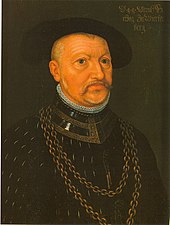



sons and daughters of the town
- Albrecht (Aberlin) Volland I (approx. 1340–1400), documented in the original feud letter of 1396 as the second of twelve judges and is considered the first prominent representative of the Grüninger Volland clan .
- Heinrich Volland senior (1390–1467), at times Vogt or "Keller" (lordly financial administrator) in Grüningen, merchant, 1448 richest citizen of Württemberg and probably responsible for the construction of the stately town hall and town hall; Father of Aberlin II, Heinrich junior and Erhard, who in 1471 together paid around two percent of the entire county’s wealth tax revenue.
- Heinrich Volland junior († 1482), also a wealthy businessman and “cellar” outside of town, married to Elisabeth, daughter of Grüninger Vogt and Württemberg chancellor Konrad Lyher, and father of Ambrosius and Philipp Volland .
- Erhart Volland († 1483), lawyer and businessman, made a good match with the rich widow Gremp in Vaihingen / Enz, became a judge there and paid taxes on the highest Vaihingen fortune.
- Johannes Reinhard alias Hans Grüninger (1455–1533), printer and publisher a. a. in Strasbourg, Lorenz Fries (physician) put a short portrait of "Margt Grieningen" (see Hermann Römer: Markgröningen in the context of Landesgeschichte I., Urgeschichte und Mittelalter . 291 p., Markgröningen 1933, p. 285).
- Ambrosius Volland (1468–1551), professor of both rights, first clergyman, then councilor and dreaded chancellor Duke Ulrichs, who tortured and executed the bailiffs of Tübingen, Cannstatt and Weinsberg because of complaints alleged to them by the emperor; after changing sides from 1522 advice of Archbishop Matthias von Salzburg, then caretaker of the Württemberg Prince Christoph, who was under imperial supervision and ennobled as advice of Emperor Charles V.
- Philipp Volland (1474–1537), lawyer and businessman, married to an aristocratic heir, was bailiff in Grüningen before (1501–1519) and after his exile (1534–1537), and from 1514 to 1519 a state representative for Stuttgart; attacked during the poor Konrads (1514) for abuse of office and grain speculation.
- Aberlin Volland III. , presumably the son of Aberlin II, at least from 1514 to 1525 a judge in Grüningen and a member of the regional government in Stuttgart.
- Martin Volland (1478–1560), from 1523 to 1527 Vogt and "Keller" in Leonberg , from 1527 to 1534 Vogt in Markgröningen; last local "boss" of the Volland company.
- Michael Volland senior (1494–1558), son of Philip, 1545 the richest Volland in Grüningen, from 1537 to 1551 Vogt in Grüningen, then in Waiblingen.
- Caspar Volland (1500–1554), professor of law and rector at the University of Tübingen and assessor at the Württemberg court.
- Michael Volland junior (* 1528, † after 1574), grandson of Philip, court procurator and fiscal general of the Reich zu Speyer; After Martin's death in 1560, leaves the Volland benefice to the Grüninger parish, admitted to the imperial nobility in 1570 and given the right to ennoble commoners.
- Younger sons and daughters of the city can be found under Markgröningen .
Personalities associated with Grüningen
- Gerold the Younger in Baar (also Gerold II .; † 799) Schwager, very trusted advisor and outstanding military leader of Charlemagne, which is why he and his Swabian successors "at all times" the pre-kick law and order office and dignity of the Reich Striker ensign has transferred ; a loan from Grüningen cannot be proven, but one from Glemsgau .
- Count Werner I of Winterthur (approx. 1000-1040), fell together with his son Liutfrid as "forerunner and standard bearer" (Latin primicerius et signifer regis ) Emperor Heinrich III. in his campaign against Břetislav I of Bohemia, when he was ambushed during an advance corresponding to his function.
- Count Werner II of Maden and Neckargau (approx. 1020-1053), fell as "primicerius et signifer regis" with his brother Adalbert II of Winterthur in the Norman Battle of Civitate, where the two brothers with 600 Swabian foot soldiers were not the only one - Italian contingent of the defeated army of Pope Leo IX. to whom they were related.
- Count Werner III. von Grüningen (approx. 1040-1065), Reichssturmfähnrich, Count von Maden, Count in Neckargau and on the Lahn (Weilburg).
- Count Werner IV. Von Grüningen (approx. 1060–1121), Reichssturmfähnrich, Count von Maden, Count in Neckargau and Burgrave of Worms, related to Counts of Württemberg and without a successor.
- King Conrad III. von Staufen (approx. 1093–1152), was 1116/20 duke in Franconia, 1127–1135 anti-king of Lothar III, but as such was defeated; Accompanied Lothar after a comparison as a committed Imperial Assault Ensign on his Italian campaign and then became king in the Roman-German Empire in 1138; held a court day in Grüningen in 1138, at which two Württemberg counts were also present.
- Count Konrad I of (Württemberg-) Grüningen, who accompanied Emperor Friedrich II on his crusade, presumably as an imperial ensign, recorded a document in Acre in 1228 for the salvation of his ancestors in favor of the German Order, which he may have joined; probably did not return from the Holy Land.
- Count Hartmann I von Grüningen (first mentioned in 1237 as "Graf von Grüningen", 1243 in Capua without male heirs, 1246 senior , † 1246), temporarily in the wake of Emperor Frederick II as an imperial ensign, probably a brother or son of Konrad I von Grüningen.
- Count Hartmann II of Grüningen (approx. 1225–1274), "Comes illustrissimus", initiated the decline of the Staufer by changing sides to the Gegenkönig in 1246; interpreted the Grüninger Reichslehen as own property and initiated the new construction of the Bartholomäuskirche .
- Count Albrecht II von Hohenberg (approx. 1235–1298), brother-in-law of King Rudolf von Habsburg, distinguished himself as the Lower Swabian provincial bailiff in the implementation of Rudolf's revindication policy (recovery of former royal property at the expense of the Württemberg counts); Albrecht used the Grüningen castle, which he brought back into imperial hands in 1280, as a second residence, hosted the princely wedding in Grüningen in 1284 in the presence of Rudolf and accompanied him on several campaigns as a presumed imperial ensign.
- Count Hartmann III. von Grüningen (* before 1250; † 1280), son of Hartmann II. and like the one who founded the bell of the Bartholomäuskirche, defended the castle and town of Grüningen against the revenge policy of King Rudolf von Habsburg until his capture in 1280 and died in the dungeon on Hohenasperg .
- Count Konrad II of Grüningen (approx. 1253-1300), son of Hartmann II, called himself from 1274 Count "von Landau", from 1280 also "von Grüningen", but had to give up the succession claim to the County of Grüningen sell local family property and suffer a serious loss of political influence.
- Konrad II von Schlüsselberg zu Grüningen (* around 1277; † 14 September 1347 ), last bearer of the name from the noble Franconian family of von Schlüsselberg , decided the battle of Mühldorf for King Ludwig of Bavaria with his knights and was awarded the imperial storm flag, castle and city of Grüningen enfeoffed, which he in 1336 at the request of Ludwig against compensation to Count Ulrich III. resigned from Württemberg .
- Aberlin Jörg (approx. 1420–1492), the most important Württemberg builder of his time, married the Vogt's daughter Adelheid von Magstatt, who lived in Grüningen, was a taxable citizen of Grüningen in 1448 and 1471 and built the large choir and the sacristy of the Bartholomäus Church (until 1472).
- Count Eberhard im Bart (1445–1496), as long as he was underage, his guardianship council resided in Grüningen; he promoted the city as a residence in the north of the Urach part of the country and included the imperial storm flag in his ducal coat of arms after King Maximilian renewed the hereditary fief with the flag, castle and city of Grüningen.
- Reinhard Gaißer (* around 1474, † after 1533), also called Gaißlin, holds a doctorate in theologian and rector of the University of Tübingen, who moved to the Grüninger Bartholomäuskirche around 1513 and was the "first social revolutionary on a Württemberg pulpit" in the wake of poor Konrad to rebel against the early capitalist acting honesty and the Grüninger Vogt Philipp Volland called.
- Wilhelm Gaisser (* around 1492), nephew of Reinhard Gaisser and not only as a clergyman (vicar) his helper in Grüningen, but also as a conspiratorial messenger to various rebel groups, especially in the Rems Valley; was still on the Engelberg after the homage and then had to leave the country, but came back, married in Grüningen and left behind at least one daughter Dorothea.
- Duke Ulrich von Württemberg (1487–1550), under the strong influence of the Grüninger Vollands, was responsible for a redistribution from bottom to top, thus provoking the uproar of poor Konrad , made concessions in the Tübingen Treaty , pushed through the Reformation in his second term and built the Hohenasperg to the modern fortress.
- Duke Christoph von Württemberg (1515–1568) had the Grüninger Reichsburg largely razed and built a Renaissance castle and the upper gate tower instead.
- Jakob Frischlin (1557–1621), schoolmaster, poet and chronicler, from whom the first mention (1593) of the Barthel-Markt as “ Schäferlauf ” comes.
- Duke Eberhard Ludwig von Württemberg (1676–1733), was at the court of the Sun King ( Ludwig XIV. ) Before 1700 and planned a Versailles in Württemberg with his mistress Wilhelmine von Graevenitz , which he realized in Ludwigsburg from 1704; took away Grüningen's functions as residence and district town , as high court and dean's office and divided the Schäferlauf into four parts .
- King Friedrich von Württemberg (1754–1816), even in the 19th century, listed the Grüningen count title as a secondary title: “We, Friderich by God's grace, King of Württemberg, sovereign Duke in Swabia and von Teck, Duke of Hohenlohe, Landgrave of Tübingen and Nellenburg, Prince of Ellwangen, ..., Count of Gröningen ... make it known ... ".
- Younger personalities can be found under Markgröningen .
Additional information
swell
- Baden-Württemberg State Archive - LA BW online
- Regesta Imperii (Source Database) - RI online
- Württembergisches Urkundenbuch (source database) - WUB online
Bibliography on city history
- 700 years of the Heilig-Geist-Spital Markgröningen . Editor: Stadt Markgröningen, 192 p., Markgröningen o. J. [1997]
- 1200 years: Markgröningen 779 to 1979. Volume 1: Festival book for the 1200th anniversary of the first documentary mention of the name . Ed .: Stadt Markgröningen, 130 p., Markgröningen 1979
- 1200 years: Markgröningen 779 to 1979. Volume 2: Documentation about the events of the city on the occasion of the first mention 1200 years ago . Ed .: Stadt Markgröningen, 87 p., Markgröningen 1979
- Bertz, Wilhelm: "I, Elisabetha Lyherin, Heinrich Vollands blessed widows ..." Considerations on the wording of a Markgröninger foundation charter from 1483. In: Volume 4 of the series Durch die Stadtbrille , pp. 54–76, ed. v. Hilde Fendrich, Markgröningen 1989
- Bertz, Wilhelm: The rich Philip and the poor Konrad. Dossier of the Gröninger Vogt Philipp Volland on the key role of pastor Reinhard Gaisser in the turmoil. In: Through the city glasses - historical research, stories and preservation of monuments in Markgröningen , Volume 10, ed. v. AGD Markgröningen, Markgröningen 2016, pp. 72–81, ISBN 3-87181-421-0
- Buck, Lothar: The two parsonages next to the Bartholomäuskirche . In: Volume 7 of the series Durch die Stadtbrille , (Markgröninger buildings and their history I.), ed. v. Working Group on Historical Research and Monument Preservation Markgröningen, pp. 29–40. Markgröningen 2002
- Bull, Karl-Otto: The Turkish tax lists as a historical source. Information about the economic and social structure of the Duchy of Württemberg in the 16th century . In: Contributions to regional studies (supplement to the state gazette for Baden-Württ.), 1974, No. 2, pp. 5–11
- Ebner, Walter: Thoughts on the Reformation - Reformation in Markgröningen in a supra-regional context . In: Through the city glasses - historical research, stories and preservation of monuments in Markgröningen , Volume 10, ed. v. AGD Markgröningen, Markgröningen 2016, pp. 82–93
- Feil, Werner: Evang. Bartholomäuskirche Markgröningen . Schnell Art Guide No. 1655, Munich and Zurich 1987
- Fendrich, Hilde: Flurgeschichte - Urgeschichte (1st part). Review of an exhibition in the Zehntscheuer May-June 1987. In: Durch die Stadtbrille, Volume 3, ed. v. Hilde Fendrich, pp. 42-60, Markgröningen 1987
- Fendrich, Hilde: The Volland in Markgröningen put under the microscope . In: Südwestdeutsche Blätter für Familien- und Wappenkunde , Vol. 23, H. 9 (2003), pp. 353–368
- Fendrich, Hilde: Dermassen vil Schweitzer. In: Volume 2 of the series "Durch die Stadtbrille", ed. v. Hilde Fendrich, pp. 47-64, Markgröningen 1986
- Fendrich, Peter: The city and its citizens in the late Middle Ages. On the social structure of the Württemberg district town of Markgröningen in the context of state history. In: Volume 3 of the series "Durch die Stadtbrille", ed. v. Hilde Fendrich, pp. 94-119, Markgröningen 1987
- Fendrich, Peter: Return of the Counts of Grüningen - Insight into the revised history of the county on the trail of Heyd . In: Through the city glasses - historical research, stories and preservation of monuments in Markgröningen , Volume 10, ed. v. AGD Markgröningen, Markgröningen 2016, pp. 40–47, ISBN 978-3000539077
- Fendrich, Peter, Günter Frank u. Erich Viehöfer: Well-known and new about the Markgröningen Castle. In: Volume 8 of the series "Durch die Stadtbrille", ed. v. Working Group on Historical Research and the Preservation of Monuments, Markgröningen, pp. 173–208, Markgröningen 2004
- Findisen, Peter : City of Markgröningen: District of Ludwigsburg. Town center atlas Baden-Württemberg 1.7. Stuttgart: Landesdenkmalamt BW u. Landesvermessungsamt BW, 1987. 30 pp.
- Fischer, Joachim: “That the poor may have a basic understanding”: an unknown order from Count Eberhard im Bart for the Markgröningen Hospital from 1468. In: From regional history and regional studies. Pp. 273-285. Stuttgart 1999
- Fries, Lorenz : Laying out the Sea Carthens or Cartha Marina . Sheet 13 on verso (an insert ascribed to Hans Grüninger ). Strasbourg 1527 (see also Römer, I., p. 285) Digitized version (1527)
- Fuchs, Karl Erwin: Landmarks of the city of Markgröningen. Along the border with the stock book . 102 p., Markgröningen 1987
- Gänsschopff, Tobias: Chronicon, or actual description of many memorable stories… Continued from about Anno 1120 to 1656… by Tobiam Gänsschopffen, the time of the German schoolmaster, milliner and organist at Marggröningen . 234 p., Stuttgart 1656 digitized
- Hermann, Helmut u. Günter Frank: Markgröningen: Portrait of a city . 132 p., Markgröningen 1992
- Hess, Hans-Burkhard: Unterriexingen - a historical kaleidoscope. Ed .: Stadt Markgröningen, 343 p., Markgröningen 1993
- Heyd, Ludwig Friedrich : The Wirtemberg Canzler Ambrosius Volland . Stuttgart 1828 ( digitized version )
- Heyd, Ludwig Friedrich: History of the former Oberamts-Stadt Markgröningen with special consideration for the general history of Württemberg, mostly based on unpublished sources . Stuttgart 1829, 268 p., Facsimile edition for the Heyd anniversary, Markgröningen 1992
- Heyd, Ludwig Friedrich: History of the Counts of Gröningen . 106 pp., Stuttgart 1829
- Liebler, Gerhard: Markgröningen. Poetic forays through the city and its history . 88 S, Markgröningen 2001
- Liebler, Gerhard: Markgröningen - Entertaining encounters with the city and its history . Edited by Working Group on Historical Research and Preservation of Monuments in Markgröningen, 107 S. Markgröningen 2011
- Lonhard, Otto-Günter : The Volland family and their connections to Entzlin, Dreher and Lyher . In: Südwestdeutsche Blätter für Familien- und Wappenkunde, Vol. 23, H. 9 (2003), pp. 368–373
- Lorenz, Sönke : The Counts of Grüningen-Landau (middle of the 13th to the beginning of the 15th century). In: Das Haus Württemberg - a biographical lexicon , ed. v. Sönke Lorenz, Dieter Mertens a . Volker Press , pp. 45-52, Kohlhammer, Stuttgart, Berlin, Cologne 1997
- Maurer, Helmut : Markgröningen . In: Die Deutschen Königspfalzen , Volume 3.1 (Baden-Württemberg), Vandenhoeck & Rupprecht, Göttingen 2004, pp. 389–404
- Memminger, Johann : The counts of Grüningen-Landau. Their name and their relationship with the house of Württemberg . In Württ. Jahrbücher, 1826, pp. 69–93 and pp. 376–440
- Mereb, Ursula: Studies on the history of ownership of the Counts and Lords of Grüningen-Landau from approx. 1250 to approx. 1500 . 108 p., Tübingen 1970
- Milde, Wolfgang, Cosima Hofacker and Manfred Frank: Barefoot over the stubble field. Schäferlauf Markgröningen: amusing, original, right in the middle. Ed .: Stadt Markgröningen, 112 p., Markgröningen 2008
- Militzer, Klaus: The Markgröninger Heilig-Geist-Spital in the Middle Ages. A contribution to the economic history of the 15th century . 214 pp., Sigmaringen 1975
- Pfaff, Karl : The origin and the earliest history of the Wirtenberg Princely House: critically examined and presented. With seven supplements, three family tables and a historical-geographical map . 111 p., Stuttgart 1836
- Riße, Robert: Johannes Reinhard alias Hans Grüninger, the early printer from Markgröningen. Exhibition catalog. 240 p., Markgröningen 1990
- Röder, Philipp LH : The city and the office of Gröningen . In: Geography and Statistics Wirtembergs, pp. 358–361. Laybach in Krain 1787 digitized
- Röder, Philipp LH: Gröningen . In: Geographical statistical-topographical lexicon of Swabia, Volume 1, pp. 619–625. Ulm 1791 digitized
- Römer, Hermann : Markgröningen in the context of regional history I., Prehistory and the Middle Ages . 291 p., Markgröningen 1933
- Römer, Hermann: Markgröningen in the context of state history II., 1550 to 1750 . Markgröningen 1930
- Sauer, Paul : Muses, power play and mistresses. Eberhard Ludwig - Duke of Württemberg and founder of Ludwigsburg . Tübingen 2008, ISBN 978-3-87407-798-9
- Schad, Petra: Markgröningen - a city guide . 80 p., Markgröningen 2003
- Schad, Petra: From the community center to the home of the community. The Wimpelinhof then and now . Ed .: Stadt Markgröningen, 72 p., Markgröningen 2005
- Schad, Petra: Markgröningen at the time of the poor Konrad . In: Ludwigsburger Geschichtsblätter 68/2014, pp. 29–58.
- Schad, Petra: How the uffrur happened there - poor Konrad and Pastor Gaisser in Markgröningen. In: Through the city glasses - historical research, stories and preservation of monuments in Markgröningen , Volume 10, ed. v. AGD Markgröningen, pp. 48-71, Markgröningen 2016, ISBN 3-87181-421-0
- Schmidlin, Johannes Christophorus: Contributions to the history of the Duchy of Wirtenberg , volume 1. Mezler, Stuttgart 1780, digitized
- Spitalkirche zum Heiligen Geist Markgröningen from 1297 to 1981. 25 years of the Heilig-Geist-Gemeinde, July 28, 1957 to July 28, 1982. Ed. the Catholic parish of Markgröningen. Markgröningen 1982.
- Tomschik, Erich u. a .: Markgröningen. The image of the city through the ages . Ed .: Stadt Markgröningen, 112 p., Markgröningen 1969
- Weinland, Johann Christoph: De Vexillo Imperii primario, vulgo Reichs-Sturm-Fahne, Commentatio academica. sn, sl 1727, ( digitized version )
Through the city glasses (city history series)
- Through the city glasses. History and stories about Markgröningen . Volumes 1 to 4 without a main topic. Edited by Hilde Fendrich, Markgröningen 1985, 1986, 1987 and 1989
- Millers, mills, hydropower . Volume 5 of the series "Durch die Stadtbrille", ed. v. Working group for historical research, heritage and monument preservation Markgröningen, 181 p., Markgröningen 1995
- Markgröningen - people and their city. Comprehensive presentation of the city's recent history in approx. 60 individual articles . Volume 6 of the series "Durch die Stadtbrille", ed. v. Working Group on Historical Research, Heritage and Monument Preservation Markgröningen, 477 p., Markgröningen 2000
- Markgröningen buildings and their history, part 1: From the Bartholomäus church to the hospital church . Volume 7 of the series "Durch die Stadtbrille", ed. v. Working Group on Historical Research and Monument Preservation Markgröningen, 132 p., Markgröningen 2002
- Markgröningen buildings and their history, part 2: Urban, stately and town houses in the Upper City . Volume 8 of the series "Durch die Stadtbrille", ed. v. Working Group on Historical Research and Monument Preservation Markgröningen, 264 p., Markgröningen 2004
- Markgröningen and its Schäferlauf. Everything about the Schäferlauf in 3 parts: Origin and development of the Schäferfest - post-war hardship, hunger for life and the return of the Schäferlauf 1947 - Schäferlauf alphabet . By Petra Schad u. Gerhard Liebler, Volume 9 of the series “Durch die Stadtbrille”, ed. v. Working Group on Historical Research and Monument Preservation Markgröningen, 121 p., Markgröningen 2007
- Through the city glasses - historical research, stories and preservation of monuments in Markgröningen , Volume 10, ed. v. AGD Markgröningen, 168 p., Markgröningen 2016, ISBN 978-3-00-053907-7
Remarks
- ↑ City map between 1818 and 1831 created by the Statistical-Topographical Bureau of the Kingdom of Württemberg as part of the Württemberg land survey begun in 1818 .
- ↑ Markgröningen is a town with around 15,000 inhabitants in the Ludwigsburg district in Baden-Württemberg and part of the German Half-timbered Road
- ↑ "In Episcopatu Spirensi quedam Domini Regis que vocatur Gruoninge spectans ad empire Scultetus ipsius Civitatis Godefridus. Ex Miraculis Sancti Mathiae “(Source: Mathias Brotherhood, Trier around 1226, engraved on the Staufer Stele Markgröningen ).
- ↑ See Heyd, Markgröningen , 1829, p. IX: Hans Grüninger describes the large spring discharge in the bet in 1527 and counts "20 scoop wells and 3 Roehrbrunnen, strongly running".
- ^ According to Hermann Römer: Markgröningen in the context of regional history I., Prehistory and the Middle Ages . 291 p., Markgröningen 1933, p. 30, the Grüninger mark was referred to as “paradise” in the tradition.
- ↑ Long- distance trade proves to be an important economic factor and source of Volland's wealth in the 15th century .
- ↑ From 496 to 746 Grüningen lay directly on the Franconian-Alemannic demarcation line , which deviated from the course of the Glems in the south and swung to the east. See map of the border line .
- ↑ In the folk tales, Gerold is mainly glorified as the “standard bearer of Charlemagne”. Compare Karl Schmid: Gerold, Graf. In: New German Biography (NDB). Volume 6, Duncker & Humblot, Berlin 1964, ISBN 3-428-00187-7 , p. 315 ( digitized version ). and Carl Voretzsch (eds.): Romanistic Works, Volume 1 , Max Niemeyer Verlag, Halle an der Saale 1922, p. 150.
- ^ A b Gustav Bossert: Württembergisches from the Codex Laureshamensis , the Traditiones Fuldenses and from Weissenburger sources . In: Dietrich Schäfer (Hrsg.): Württembergische Geschichtsquellen, Vol. 2. Stuttgart 1895, p. 208, excerpt as PDF
- ↑ In the High Middle Ages, the spellings Grieningen , Grunyngen , Gryningen , Grunigen and later Greiningen and Gröningen appear next to Grüningen . Grüningen prevailed in official documents ; in the 17th century Gröningen is increasingly found . Markgröningen was not officially adapted until the 18th century. However, neither from King Friedrich , who in 1806 still had the secondary title “Count of Gröningen”, nor from the city's magistrate, who of course wrote “Gröningen” in a petition to the new King Wilhelm on November 20, 1816 .
- ↑ Cf. Heyd, Ludwig Friedrich: History of the Counts of Gröningen . 106 pp., Stuttgart 1829, pp. 1ff
- ↑ According to Röder , in Geographisches Statistisches-Topographisches Lexikon von Schwaben , Volume 1, Ulm 1791, p. 619, initially only the “rabble” named the city “Markgröningen”. Digital version of the BSB (PDF)
- ↑ Source: Fries, L., 1527, passage inserted by the publisher and printer Hans Grüninger; as a facsimile from Hermann Römer: Markgröningen in the context of regional history I., Prehistory and the Middle Ages . 291 S., Markgröningen 1933, p. 285
- ↑ Heinrich Hermelink , The matriculations of the University of Tübingen from 1477–1600. Stuttgart 1906. p. 266. Tübingen matriculation online
- ↑ See "Grüningen" or "Marckt Gröningen" in the Topographia Germaniae - digitized version at Wikisource .
- ↑ See picture on landesarchiv-bw.de
- ↑ In a petition to King Wilhelm I, the magistrate still called the city Gröningen in 1816 . Liebler, Gerhard: Markgröningen - Entertaining encounters with the city and its history . Edited by Working Group on Historical Research and Monument Preservation Markgröningen, 107 p. Markgröningen 2011, p. 97f
- ↑ In 1590 the already quite reliable cartographer Georg Gadner located Pulverdingen instead of on the southern edge north of the Untere Pulverdinger Holz , where Andreas Kieser recorded a desolation near the former castle Dauseck in 1682 on the forest map 158 .
- ↑ Source: Landesarchiv BW online
- ↑ Motif: contemporary figure speaking with hands in front of the Bartholomäuskirche ; see Working Group on Historical Research and Preservation of Monuments in Markgröningen ( Memento of the original from July 14, 2014 in the Internet Archive ) Info: The archive link was inserted automatically and has not yet been checked. Please check the original and archive link according to the instructions and then remove this notice.
- ↑ Württ. Urkundenbuch Volume II., No. 312, pp. 13-14 WUB online
- ↑ According to Crusius (Heyd, Ludwig Friedrich: Geschichte der Grafen von Gröningen . 106 p., Stuttgart 1829, p. 9): "Anitzo the city pastor lives in the castle, where the old counts once resided"
- ↑ Also called the Battle of the Nidda after this river west of Frankfurt.
- ↑ Comes = Count; Hartmann's attribute illustrissimus is translated as high born or illustrious .
- ↑ Source: WUB Volume X., No. 4708, pp. 378–379 WUB online
- ↑ See Heyd, Ludwig Friedrich: History of the former Oberamts-Stadt Markgröningen with special consideration for the general history of Württemberg, mostly based on unpublished sources . Stuttgart 1829, p. 7
- ↑ See document from King Ludwig, the Bavarian , of October 3, 1322 for Konrad II von Schlüsselberg in: Regesta Imperii VII H. 1 n. 28 RI online
- ↑ Source: [RI VII] H. 1 n. 264 - Regesta Imperii online
- ↑ Source: Document of July 23, 1495 as an original copy from Hermann Römer: Markgröningen in the context of Landesgeschichte I., Urgeschichte und Mittelalter . 291 S., Markgröningen 1933, pp. 187f; as regest (RI XIV, 1 n. 2164) at Regesta Imperii online
- ↑ The field name Hochgericht still refers to the court at the western end of the marker (at the B10).
- ↑ Source: Archival documents in "causa equestri" , Cap. I., Sect. I. No. 5, p. 5, and Hermann Römer: Eine Markgröninger Bürgerliste from 1396 , in: Blätter für Württembergische Familienkunde 5 (1932–34), pp. 85–89, and Heyd, Ludwig Friedrich: Geschichte der vormaligen Oberamts -Stadt Markgröningen with special regard to the general history of Württemberg, mostly based on unpublished sources . Stuttgart 1829, p. 33ff
- ↑ See Fendrich, Peter: The city and its citizens in the late Middle Ages. On the social structure of the Württemberg district town of Markgröningen in the context of state history. In: Volume 3 of the series "Durch die Stadtbrille", ed. v. Hilde Fendrich, pp. 94-119, Markgröningen 1987, pp. 94-119.
- ↑ See Fendrich, Peter: The city and its citizens in the late Middle Ages. On the social structure of the Württemberg district town of Markgröningen in the context of state history. In: Volume 3 of the series "Durch die Stadtbrille", ed. v. Hilde Fendrich, pp. 94-119, Markgröningen 1987, p. 102
- ↑ See Gustav Toepke : Die Matrikel der Universität Heidelberg from 1386 to 1662. Heidelberg 1884. Heidelberger Matrikel online
- ^ See Heinrich Hermelink : The matriculations of the University of Tübingen from 1477–1600. Stuttgart 1906 Tübingen matriculation online
- ↑ See Hermann Mayer: Die Matrikel der Universität Freiburg i. Br. From 1460 to 1656. Freiburg 1907. Freiburg register online
- ↑ See Hermann Römer: Markgröningen in the context of Landesgeschichte I., Prehistory and the Middle Ages . 291 S., Markgröningen 1933, pp. 190ff, who made the Vollands jointly responsible for early capitalist grievances and described Gaisser's activities in detail.
- ↑ See Römer, reprint in: Spitalkirche zum Heiligen Geist Markgröningen from 1297 to 1981. 25 years of the Holy Spirit Congregation, July 28, 1957 to July 28, 1982. Ed. the Catholic parish of Markgröningen. Markgröningen 1982, p. 73
- ↑ See 450 Years of the Reformation in Esslingen (exhibition catalog), ed. v. Esslingen City Archives, Sigmaringen 1981, p. 119f
- ↑ See Fendrich, Peter: The city and its citizens in the late Middle Ages. On the social structure of the Württemberg district town of Markgröningen in the context of state history. In: Volume 3 of the series "Durch die Stadtbrille", ed. v. Hilde Fendrich, pp. 94-119, Markgröningen 1987, pp. 108-114.
- ↑ See Hermann Mayer: Die Matrikel der Universität Freiburg i. Br. From 1460 to 1656. Freiburg 1907, p. 480. Freiburg matriculation online
- ↑ a b See Schad, Petra: From the community center to the home of the community. The Wimpelinhof then and now . Ed .: Stadt Markgröningen, 72 p., Markgröningen 2005
- ↑ Wendel Bilfinger: Real description of what happened with the well-known fortress Hohen-Asperg, the same location, siege and final surrender, from Augusto of the 1634th to the following August 1635th . In: Johannes Christophorus Schmidlin: Contributions to the history of the Duchy of Wirtenberg , Volume 1. Mezler, Stuttgart 1780, p. 199ff, digitized .
- ↑ See Fendrich, H., 1986, pp. 47-64
- ↑ See Heyd, Ludwig Friedrich: History of the former Oberamts-Stadt Markgröningen with special consideration for the general history of Württemberg, mostly based on unpublished sources . Stuttgart 1829, p. 112f, and 1200 years: Markgröningen 779 to 1979. Volume 1: Festival book for the 1200th anniversary of the first documentary mention of the name . Ed .: Stadt Markgröningen, 130 p., Markgröningen 1979, p. 104
- ↑ See Fendrich, Peter: The city and its citizens in the late Middle Ages. On the social structure of the Württemberg district town of Markgröningen in the context of state history. In: Volume 3 of the series "Durch die Stadtbrille", ed. v. Hilde Fendrich, pp. 94-119, Markgröningen 1987, p. 116
- ↑ See Heyd, Ludwig Friedrich: History of the former Oberamts-Stadt Markgröningen with special consideration for the general history of Württemberg, mostly based on unpublished sources . Stuttgart 1829, p. 113
- ↑ a b Peter Fendrich, Günter Frank u. Erich Viehöfer: Well-known and new about the Markgröningen Castle. In: “Through the city glasses”, Volume 8, Markgröningen 2004, pp. 173–208.
- ↑ See Heyd, Ludwig Friedrich: History of the former Oberamts-Stadt Markgröningen with special consideration for the general history of Württemberg, mostly based on unpublished sources . Stuttgart 1829, p. 116
- ↑ See Liebler, Gerhard: Markgröningen - short encounters with the city and its history . Edited by Working Group on Historical Research and Monument Preservation Markgröningen, 107 p. Markgröningen 2011, p. 90ff
- ↑ As a contemporary affected by the consequences, Heyd, Ludwig Friedrich describes: History of the former Oberamts-Stadt Markgröningen with special regard to the general history of Württemberg, mostly based on unpublished sources . Stuttgart 1829, p. 120ff, the mood of the Groeningers is very impressive.
- ↑ On the far left or heraldically on the right, a crown of a count with an imperial eagle can be seen as a crest, which stands for the county of Grüningen.
- ↑ See Johann Daniel Georg von Memminger: The Counts of Grüningen-Landau. Their name and their relationship with the house of Württemberg . In Württ. Jahrbücher, 1826, pp. 69–93 and pp. 376–440.
- ↑ Sources: The corresponding publications by the authors named here can be found in the literature list.
- ^ Sale of the "Herrschaft Grüningen" (church with patronage and manor with land) to King Adolf . See WUB Volume X., No. 4708, pp. 378-379 WUB online
- ↑ Quotation from the state bibliography of Baden-Württemberg (BSZ)
- ↑ For example the Bartholomäus Chapel in Paderborn , built around 1017, or the Bartholomäus Church in Ilsfeld
- ↑ Proof by the Astronomical Institute of the University of Tübingen (see graphic on eastward deviation and patronage)
- ↑ Source: Hospital bills, see Militzer, Klaus: The Markgröninger Heilig-Geist-Spital in the Middle Ages. A contribution to the economic history of the 15th century . 214 pp., Sigmaringen 1975
- ↑ See Lorenz Fries: Laying of the Sea Carthen or Cartha Marina . Sheet 13 or Hermann Römer: Markgröningen in the context of regional history I., Prehistory and the Middle Ages . 291 p., Markgröningen 1933, facsimile on p. 285
- ↑ See pictures of demolished buildings in Grüningen .
- ↑ Quotation from Hans Grüninger in Lorenz Fries: Application of the Sea Carthen or Cartha Marina . Sheet 13 on verso (an insert ascribed to Hans Grüninger). Strasbourg 1527
- ↑ Markgröningen 2012 on stauferstelen.net. Retrieved March 23, 2014.
- ↑ Grüningen was first named town in 1226.
- ↑ See the official coat of arms of 1596 .
- ^ Johann Samuelersch , Johann Gottfried Gruber : General Encyclopedia of Sciences and Arts . First section. Sixty-first part. Bibliographisches Institut & FA Brockhaus, Leipzig 1855, p. 437
- ↑ Document of July 23, 1495 in the main state archive in Stuttgart, Regesten 713, and as Regest (RI XIV, 1 n. 2164) online at Regesta Imperii ; Complete copy from Hermann Römer: Markgröningen in the context of regional history I., Prehistory and the Middle Ages . 291 pp., Markgröningen 1933, pp. 187f.
- ↑ See 450 Years of the Reformation in Esslingen (exhibition catalog), ed. v. Esslingen City Archives, Sigmaringen 1981, p. 119f and p. 143.
- ^ Hermann Römer: Markgröningen in the context of regional history I., Prehistory and the Middle Ages . 291 pp., Markgröningen 1933, pp. 190ff.
See also
Further historical aspects of Markgröningen can be found in the following articles:
- Markgröningen : Modern city history from 1718.
- Glemsgau , Amt (from 1758 Oberamt) Grüningen and Kameralamt Markgröningen as well as Landkapitel Grüningen and Archidiakonat Trinitatis on historical geography.
- Unterriexingen (suburb) with castle , Frauenkirche and Dauseck castle .
- Deserted areas near Markgröningen , especially Vöhingen and Remmigheim with the Remminger Schlössle , which today belong to the Schwieberdinger and Untermberger markings.
- Schäferlauf : the traditional Markgröninger folk festival, formerly a Kirchweih festival ( cherry ) and fair.
- Grüninger building under monument protection .
- Bartholomäuskirche : rebuilt in the 13th century by the Counts of Grüningen.
- Heilig-Geist-Spital : donated by the Counts of Grüningen, church consecration in 1297.
- Reichsburg Grüningen and Residenzschloss Grüningen .
- Town hall : built from 1441, at that time the largest commercial and town hall in Württemberg.
- Obere Mühle : Disappeared Glemsmühle , where Hans Grüninger is said to have grown up.
- Pulvermühle : Disappeared Glemsmühle above the hamlet of Talhausen .
- Schluesselburg : lost castle on the Schlüsselberg above Talhausen.
- Reichssturmfahne , the associated right of litigation and the coat of arms of Württemberg .
- Count Werner III. von Grüningen , Count Werner IV. von Grüningen , Count Hartmann II. von Grüningen , Count Hartmann III. von Grüningen and Konrad II. von Schlüsselberg "zu Grüningen" .
- Aberlin Jörg : builder from Württemberg, citizen of Grüningen, where he built the choir and sacristy of the town church.
- Hans Grüninger : printer and publisher, published the first geographical description of Grüningen.
- Reinhard Gaißer : Reform theologian who was the “first social revolutionary in a Württemberg pulpit” ( Roman ) who supported the uprising of poor Konrad .
- Volland clan : in the late Middle Ages, the ruling patrician family in Grüningen; outstanding: Ambrosius Volland and Philipp Volland .
Web links
- Official website of the city
- Working group for historical research and monument preservation in Markgröningen
Coordinates: 48 ° 54 '18.4 " N , 9 ° 4' 49.1" E









